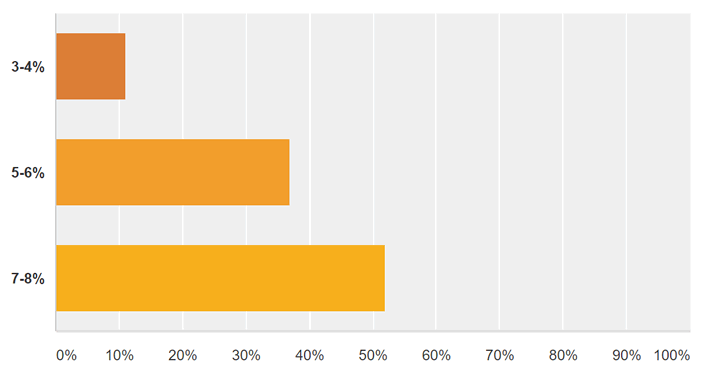According to the January LANDTHINK Pulse results, 51.99% of respondents indicated that a 7-8% interest rate is too high for investing in land. Interest rates have been steadily rising since the November presidential election, and there is a lot of speculation on whether or not higher interest rates might thwart would-be land buyers throughout 2017.
When purchasing raw land for sale (unimproved and undeveloped), would-be purchasers must already be prepared to plunk down a hefty down payment of anywhere from 20-50% and expect to be charged a much higher interest rate than traditional home loans. But based on the response to last month’s survey question, a 7-8% interest rate is simply too high for potential land investors to take the leap.
Last month, the January Pulse asked: Which interest rate range is too high for investing in land? Our audience held mixed views on what they deemed to be an interest rate too high to consider investing in land. Over half of the respondents (51.99%) said 7-8% was too high, followed by 37.00%, who said 5-6% was too high. Only 11.01% indicated 3-4% interest was too high to invest in land.
There is no need for would-be land buyers to panic. In fact, buyers should instead focus on why interest rates are rising. Higher interest rates are a signal that the current economy is strong and consumer activity is high- great for the overall real estate market. If a buyer is concerned with rising interest rates, chances are the seller is also. This might lead to a buyer scoring a pretty sweet deal on a property that’s been on their radar. However, those potential buyers, previously content with sitting on the fence, might be wise to make a move sooner rather than later. Continued economic improvement typically pushes home and land prices upward over a period of time.
Land investors should not allow rising interest rates to discourage them from going after a land loan for a property they want to own. The amount of interest charged will largely depend on several factors, such as how much is borrowed, the strength of the buyers’ application, as well as the type of loan and the intended land use. Lenders will work closely with buyers and do the best they can to help them obtain financing for land. Local banks and credit unions are usually a good place to start, since they often have knowledge of the property and the area. In the LANDTHINK article “Funding Your Land Investment”, Robert King, land agent at Southeastern Land Group, offers a brief explanation of the most commonly used methods to fund land transactions that those beginning the process of purchasing land might find helpful.
Buyers should seek advice from several lending professionals and explore all financing options, including owner financing and home equity line of credit, which has a lower interest rate than land loans.
Here are the final results:

- 51.99% said 7-8% was too high for investing
- 37.00% said 5-6% was too high for investing
- 11.01% said 3-4% was too high for investing
Thank you to everyone who participated and shared the Pulse with friends and connections in the land industry.
Become a Pulse sponsor! It’s a great way to ensure your brokerage is the first one buyers and sellers call when they have a need to buy or sell property. You’ll get insane exposure on Social + Email + Web. That’s 500,000+ monthly eyes on you! Once you have it, you won’t want to give it up! Pulse sponsorships are offered on a limited, first come first served basis and are subject to certain limitations. If your business would be interested in sponsoring the March Pulse question, please contact us soon.
Do you have a suggestion for next month’s Pulse question? Submit your question here and we might choose yours!
What action should the federal government take with regard to increasing or decreasing EPA regulations? We’d like to know! Click here to answer the February Pulse question.
This content may not be used or reproduced in any manner whatsoever, in part or in whole, without written permission of LANDTHINK. Use of this content without permission is a violation of federal copyright law. The articles, posts, comments, opinions and information provided by LANDTHINK are for informational and research purposes only and DOES NOT substitute or coincide with the advice of an attorney, accountant, real estate broker or any other licensed real estate professional. LANDTHINK strongly advises visitors and readers to seek their own professional guidance and advice related to buying, investing in or selling real estate.










Add Comment